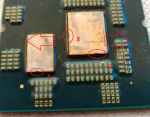Hello,
today i received some fun stuff:
I delidded already a couple CPU
(3770K/6700K/7700K/13900KF/14900KF/14900KS and some more for my friends)
So i think at least i know what i´m doing...
But i was still careful and before i sacrify my 9950X3D i´ll
gave it a shot on my 7600X3D.
and probably this was the best decission i made in the last months:
this is what the I/O die now looks like:
![]()
here is the total of the delidded CPU:
![]()
you can clearly see damage in the marked spots:
![]()
Spot 3 could be from the delid process but for 1 and 2
I have no explanation.
The delidder moves that way:
![]()
Did anyone of you discover the same or a similar issue with deliding?
today i received some fun stuff:
- Delid Die Mate
- AMD Mycro Direct Die Pro
- Conductonaut extreme
- some tubing and new fittings
I delidded already a couple CPU
(3770K/6700K/7700K/13900KF/14900KF/14900KS and some more for my friends)
So i think at least i know what i´m doing...
But i was still careful and before i sacrify my 9950X3D i´ll
gave it a shot on my 7600X3D.
and probably this was the best decission i made in the last months:
this is what the I/O die now looks like:

here is the total of the delidded CPU:

you can clearly see damage in the marked spots:

Spot 3 could be from the delid process but for 1 and 2
I have no explanation.
The delidder moves that way:

Did anyone of you discover the same or a similar issue with deliding?








